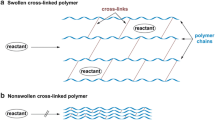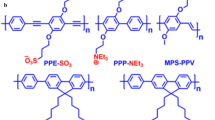Abstract
Many interests have been focused on prolyl cis–trans isomerization which is related to protein folding and isomer-specific biochemical recognition. Since polyproline can adopt either type I (PPI) helices with all cis amide bonds or type II (PPII) helices with all trans amide bonds, it has been a valuable model to study the prolyl isomerization. Recent studies have shown that stereoelectronic effects govern the stability of PPII structure and the rate of PPII → PPI conversion. To further explore the terminal stereoelectronic effects on polyproline conformation, herein we synthesized a series of host–guest peptides in which (2S,4S)-4-fluoroproline (flp) or (2S,4R)-4-fluoroproline (Flp) residues are incorporated into the C- or N-terminal end of a peptide and studied the thermodynamic and kinetic consequences on polyproline conformation. Circular dichroism measurements revealed that inserting 4-fluoroproline residues into the C terminus of a polyproline peptide induces a great stereoelectronic effect on PPII stability and PPII → PPI conversion rates. From the C terminus, a (Flp)3 triplet stabilizes PPII structure and increases the transition barrier of PPII → PPI conversion by 1.53 kJ mol−1 while a (flp)3 triplet destabilizes PPII conformation and reduce the PPII → PPI transition barrier by 4.61 kJ mol−1. In contrast, the 4-fluoroproline substitutions at the N terminus do not exhibit distinct stereoelectronic effects on PPII stability and PPII → PPI conversion rates. Our data demonstrate that the C-terminal stereoelectronic effects have a more dramatic impact on PPII stability and PPII → PPI conversion kinetics.




Similar content being viewed by others
References
Adzhubei AA, Sternberg MJE (1993) Left-handed polyproline-II helices commonly occur in globular-proteins. J Mol Biol 229:472–493. doi:10.1006/jmbi.1993.1047
Adzhubei AA, Sternberg MJE, Makarov AA (2013) Polyproline-II helix in proteins: structure and function. J Mol Biol 425:2100–2132. doi:10.1016/j.jmb.2013.03.018
Brandsch M, Thunecke F, Küllertz G, Schutkowski M, Fischer G, Neubert K (1998) Evidence for the absolute conformational specificity of the intestinal H+/peptide symporter, PEPT1. J Biol Chem 273:3861–3864. doi:10.1074/jbc.273.7.3861
Chiang Y-C, Lin Y-J, Horng J-C (2009) Stereoelectronic effects on the transition barrier of polyproline conformational interconversion. Protein Sci 18:1967–1977. doi:10.1002/pro.208
Cubellis MV, Caillez F, Blundell TL, Lovell SC (2005) Properties of polyproline II, a secondary structure element implicated in protein–protein interactions. Proteins 58:880–892. doi:10.1002/prot.20327
Dugave C, Demange L (2003) Cis–trans isomerization of organic molecules and biomolecules: implications and applications. Chem Rev 103:2475–2532. doi:10.1021/cr0104375
Ferreon JC, Hilser VJ (2003) The effect of the polyproline II (PPII) conformation on the denatured state entropy. Protein Sci 12:447–457. doi:10.1110/ps.0237803
Fischer G (2000) Chemical aspects of peptide bond isomerisation. Chem Soc Rev 29:119–127. doi:10.1039/a803742f
Grimsley GR, Pace CN (2003) Spectrophotometric Determination of Protein Concentration. In: Current Protocols in Protein Science. John Wiley & Sons, Inc., pp 3.1.1–3.1.9. doi:10.1002/0471140864.ps0301s33
Hamburger JB, Ferreon JC, Whitten ST, Hilser VJ (2004) Thermodynamic mechanism and consequences of the polyproline II (P-II) structural bias in the denatured states of proteins. Biochemistry 43:9790–9799. doi:10.1021/bi049352z
Hinderaker MP, Raines RT (2003) An electronic effect on protein structure. Protein Sci 12:1188–1194. doi:10.1110/ps.0241903
Horng J-C, Raines RT (2006) Stereoelectronic effects on polyproline conformation. Protein Sci 15:74–83. doi:10.1110/ps.051779806
Kakinoki S, Hirano Y, Oka M (2005) On the stability of polyproline-I and II structures of proline oligopeptides. Polym Bull 53:109–115. doi:10.1007/s00289-004-0317-6
Kleywegt GJ, Jones TA (1996) Phi/psi-chology: ramachandran revisited. Structure 4:1395–1400. doi:10.1016/S0969-2126(96)00147-5
Knof S, Engel J (1974) Conformational stability, partial specific volumes and spectroscopic properties of poly-l-proline, poly-l-hydroxyproline and some of its O-acyl-derivatives in various solvent systems. Isr J Chem 12:165–177. doi:10.1002/ijch.197400016
Kuemin M, Schweizer S, Ochsenfeld C, Wennemers H (2009) Effects of terminal functional groups on the stability of the polyproline II structure: a combined experimental and theoretical study. J Am Chem Soc 131:15474–15482. doi:10.1021/ja906466q
Lin L-N, Brandts JF (1979) Role of cis-trans isomerism of the peptide bond in protease specificity. Kinetic studies on small proline-containing peptides and on polyproline. Biochemistry 18:5037–5042. doi:10.1021/bi00590a002
Lin L-N, Brandts JF (1980) Kinetic mechanism for conformational transitions between poly-l-prolines I and II: a study utilizing the cis-trans specificity of a proline-specific protease. Biochemistry 19:3055–3059. doi:10.1021/bi00554a034
Mezei M, Fleming PJ, Srinivasan R, Rose GD (2004) Polyproline II helix is the preferred conformation for unfolded polyalanine in water. Proteins 55:502–507. doi:10.1002/prot.20050
Mutter M, Wohr T, Gioria S, Keller M (1999) Pseudo-prolines: induction of cis/trans-conformational interconversion by decreased transition state barriers. Biopolymers (Pept Sci) 51:121–128. doi:10.1002/(SICI)1097-0282(1999).51:2<121:AID-BIP2>3.0.CO;2-O
Reimer U, Scherer G, Drewello M, Kruber S, Schutkowski M, Fischer G (1998) Side-chain effects on peptidyl-prolyl cis/trans isomerisation. J Mol Biol 279:449–460. doi:10.1006/jmbi.1998.1770
Sarkar P, Reichman C, Saleh T, Birge RB, Kalodimos CG (2007) Proline cis–trans isomerization controls autoinhibition of a signaling protein. Mol Cell 25:413–426. doi:10.1016/j.molcel.2007.01.004
Scopes RK (1974) Measurement of protein by spectrophotometry at 205 nm. Anal Biochem 59:277–282. doi:10.1016/0003-2697(74)90034-7
Shi ZS, Woody RW, Kallenbach NR (2002) Is polyproline II a major backbone conformation in unfolded proteins? Adv Protein Chem 62:163–240
Shi ZS, Chen K, Liu ZG, Kallenbach NR (2006) Conformation of the backbone in unfolded proteins. Chem Rev 106:1877–1897. doi:10.1021/cr040433a
Shoulders MD, Raines RT (2009) Collagen structure and stability. Annu Rev Biochem 78:929–958. doi:10.1146/annurev.biochem.77.032207.120833
Siligardi G, Drake AF (1995) The importance of extended conformtions and, in particular, the PII conformation for the molecular recognition of peptides. Biopolymers 37:281–292. doi:10.1002/bip.360370406
Stapley BJ, Creamer TP (1999) A survey of left-handed polyproline II helices. Protein Sci 8:587–595. doi:10.1110/ps.8.3.587
Steinberg IZ, Harrington WF, Berger A, Sela M, Katchalski E (1960) The configurational changes of poly-l-proline in solution. J Am Chem Soc 82:5263–5279. doi:10.1021/ja01505a001
Vanhoof G, Goossens F, De Meester I, Hendriks D, Scharpe S (1995) Proline motifs in peptides and their biological processing. FASEB J 9:736–744
Wedemeyer WJ, Welker E, Scheraga HA (2002) Proline cis–trans isomerization and protein folding. Biochemistry 41:14637–14644. doi:10.1021/bi020574b
Whittington SJ, Chellgren BW, Hermann VM, Creamer TP (2005) Urea promotes polyproline II helix formation: implications for protein denatured states. Biochemistry 44:6269–6275. doi:10.1021/bi050124u
Acknowledgments
We are grateful to Ministry of Science and Technology, Taiwan (NSC 101-2113-M-007-017-MY2 and NSC 101-2738-M-007-004) and National Tsing Hua University (102N2011E1) for support of this work. We also thank the National Center for High-performance Computing (NCHC) for computer time and facilities.
Conflict of interest
The authors declare that they have no conflict of interest.
Author information
Authors and Affiliations
Corresponding author
Electronic supplementary material
Below is the link to the electronic supplementary material.
Rights and permissions
About this article
Cite this article
Lin, YJ., Horng, JC. Impacts of terminal (4R)-fluoroproline and (4S)-fluoroproline residues on polyproline conformation. Amino Acids 46, 2317–2324 (2014). https://doi.org/10.1007/s00726-014-1783-2
Received:
Accepted:
Published:
Issue Date:
DOI: https://doi.org/10.1007/s00726-014-1783-2




